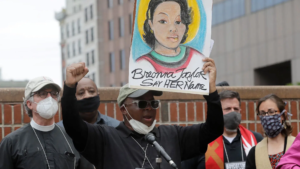This is the thirid post of “The Context”—a biweekly series of archival stories—offering our readers a useful background to some of the most important subjects in the news today. We hope you enjoy it.
IN THE PAST FEW YEARS, universities across the country have made efforts to acknowledge and address evidence of their historical links to slavery. But many of their students are not satisfied with the pace of progress. The Associated Press recently wrote about how students and activists are pushing institutions to examine their pasts more seriously. These efforts are taking place at Brown—where “undergraduate students voted overwhelmingly for the university to identify the descendants of slaves who worked on campus and begin paying them reparations”—and at Georgetown, the University of Georgia, Trinity College, and the University of Virginia, among others.
Harvard is no stranger to these conversations (though reparations have not yet been a major subject of University discussions). Editor John S. Rosenberg wrote a comprehensive article on Harvard’s pledge to confront its past associations with slavery in April 2016. Among those efforts was the unveiling of a plaque on Wadsworth House that names Titus, Venus, Juba, and Bilhah—four enslaved people who worked for Harvard presidents Benjamin Wadsworth and Edward Holyoke, who served between 1725 and 1769. (Just last week, the plaque served as inspiration for a moving graduation speech by Vincent H. Bish, Jr., Ed.M ’21.) Later that year, the Harvard Corporation decided to abandon the Harvard Law School shield, which paid homage to slave owner and benefactor Isaac Royall Jr. Rosenberg’s article featured insights from Bell professor of history Sven Beckert, who led the student-inspired Harvard and Slavery Project that began in 2007. (Beckert’s own research on the global history of slavery is detailed in managing editor Jon Shaw’s excellent 2014 feature.) That group discovered:
Harvard presidents who brought slaves to live with them on campus, significant endowments drawn from the exploitation of slave labor, Harvard’s administration and most of its faculty favoring the suppression of public debates on slavery. A quest that began with fears of finding nothing ended with a new question—how was it that the university had failed for so long to engage with this elephantine aspect of its history?
Harvard has devoted more resources to this self-investigation during the past few years. At a 2017 Radcliffe Institute conference devoted to exploring Harvard’s history with slavery, keynote speaker Ta-Nehisi Coates said, “We talk about enslavement as if it were a bump in the road. And I tell people: it’s the road. It’s the actual road.” He later argued that every school with close historical ties to slavery “needs to make reparations.”
A boost to Harvard’s studies came in November 2019, when President Lawrence S. Bacow announced an “initiative on Harvard and the legacy of slavery”—backed by $5 million in initial funding. At a recent online conference, Radcliffe Institute dean Tomiko Brown-Nagin—who leads the initiative—said of Harvard’s promised reckoning with that shameful past, “This is a beginning; it’s not an ending.” Surely this is true. In January 2021, the Peabody Museum found in its holdings the remains of 15 people of African descent who were likely alive when slavery was legal in the United States. “On behalf of the University community,” President Bacow wrote, “I apologize for Harvard’s role in collection practices that placed the academic enterprise above respect for the dead and human decency.”
Though not directly tied to the University’s acknowledgment of its own historical associations with racism and enslavement, two features—both by Harvard’s president emerita, Drew Gilpin Faust—provide an intimate look at these larger topics. In this excerpt from her 2008 book, This Republic of Suffering: Death and the American Civil War, she writes, “Slavery had divided the nation, but assumptions of racial hierarchy would unite whites North and South in a century-long abandonment of the emancipationist legacy.” And I love this essay she wrote in 2003 about a letter she sent to President Dwight Eisenhower when she was nine years old. Her reflection on the note, and the segregated era in which it was written, is worth reading.
~Jacob Sweet, Associate Editor




